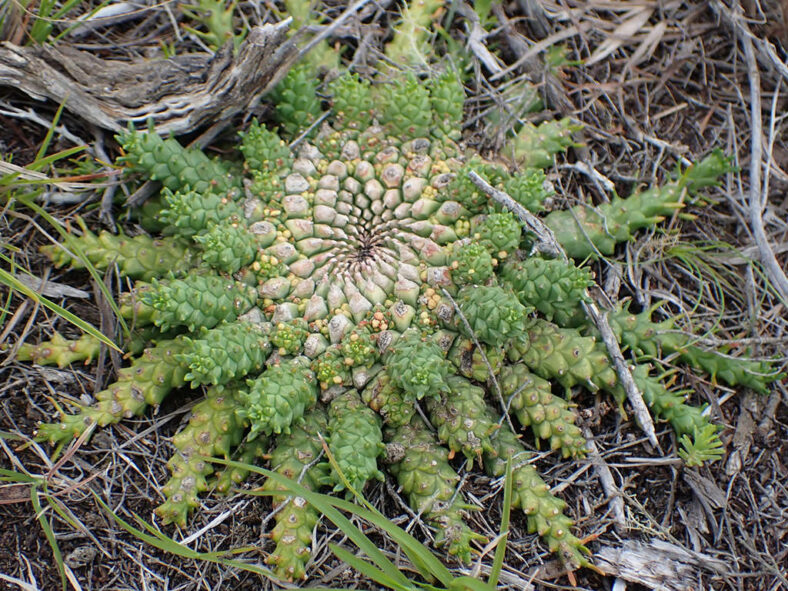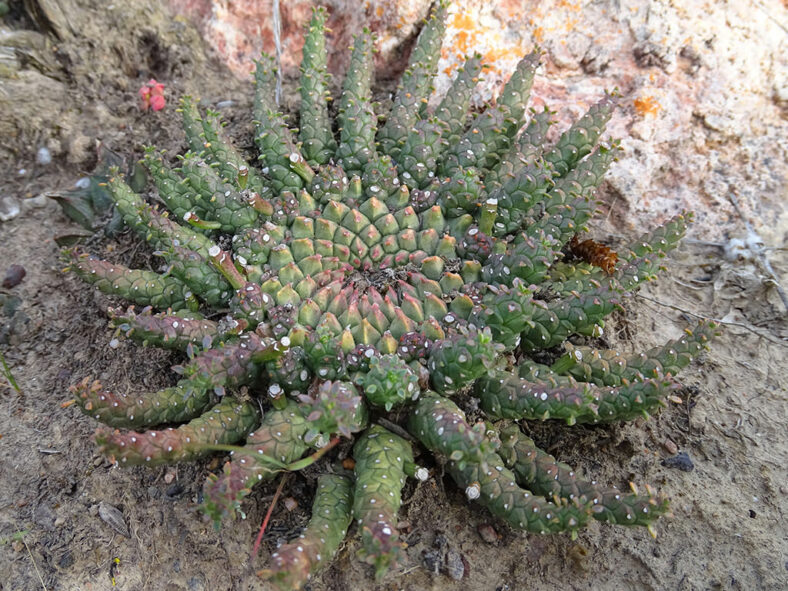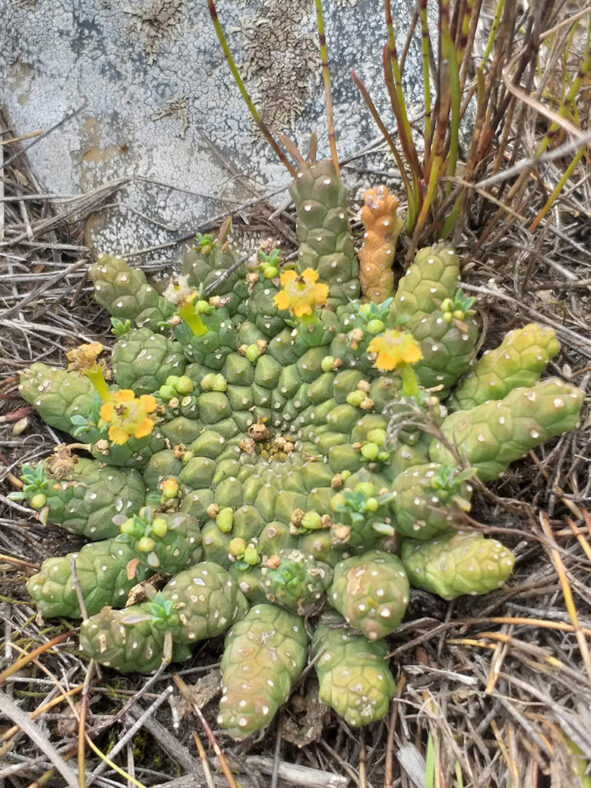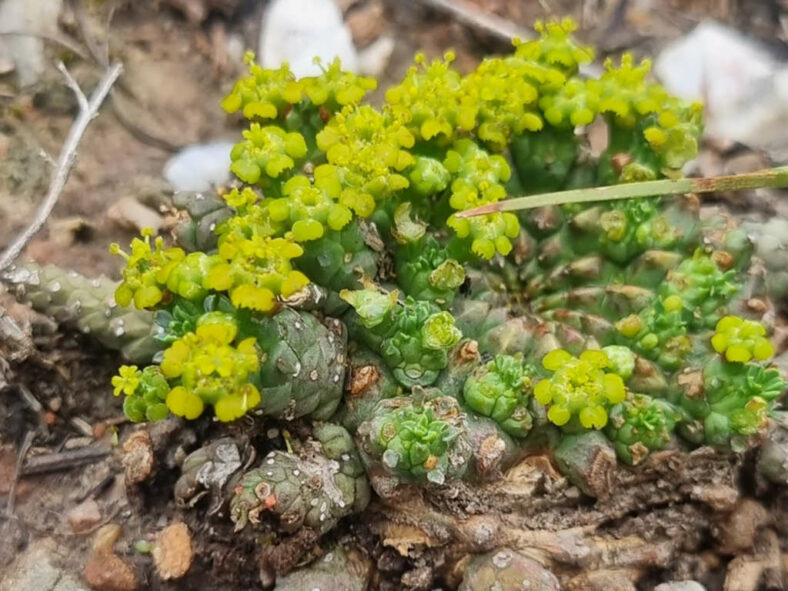Euphorbia procumbens is a member of the Medusoid Euphorbias group. This species has branches that do not cover the top of the main stem, resembling Euphorbia gorgonis. However, it can be clearly distinguished from the latter by its longer leaves and the shape and color of its involucral glands.
Scientific Name
Euphorbia procumbens Mill.
Common Name(s)
Snake Milkball
Synonym(s)
Euphorbia pugniformis, Medusea procumbens
Scientific Classification
Family: Euphorbiaceae
Subfamily: Euphorbioideae
Tribe: Euphorbieae
Subtribe: Euphorbiinae
Genus: Euphorbia
Etymology
The specific epithet "procumbens" (pronounced pro-KUM-benz) means "falling forwards, sinking down, prostrating" and refers to this species' growth habit.
Origin
Euphorbia procumbens is endemic to South Africa. It grows on gravelly patches among short bushes in fynbos, grassland, or karroid veld from Riversdale to Mossel Bay in the Western Cape to Willowmore in the Eastern Cape province.
Description
Euphorbia procumbens is a dwarf succulent with a short, swollen stem bearing rosettes of spreading, cylindrical branches covered with conical tubercles. This plant can grow up to 2 inches (5 cm) tall and has a large, slightly depressed central area that is branchless and covered with tubercles. Its typical form has 2 to 3 rows of branches. The stem is partly buried in the ground and can reach a diameter of 4 inches (10 cm). The branches range in color from brownish to greyish-green and can grow up to 4 inches (10 cm) in length and 0.4 inches (1 cm) in diameter. The leaf-rudiments are deciduous, linear to lance-shaped, and can measure up to 0.3 inches (0.8 cm) long.
The cyathia are solitary, with five green to purple glands mostly slightly toothed along the edges. They appear in spring and summer on stout, deciduous peduncles and can reach up to 0.3 inches (0.7 cm) in diameter. The fruits are somewhat bluish capsules covered with short, soft hair and can grow up to 0.25 inches (0.6 cm) in diameter.

How to Grow and Care for Euphorbia procumbens
Light: For optimal growth, Euphorbia procumbent needs plenty of sunlight. Place it near a sunny window or move it to your balcony or garden during the warmer months, gradually increasing sun exposure to avoid sunburn.
Soil: Use a well-draining soil, either a commercial potting mix formulated for succulents or create your own well-draining soil.
Temperature: While high summer temperatures are not a problem, low winter temperatures can damage or kill your plant. Euphorbia procumbens grows best in USDA Plant Hardiness Zones 10a to 11b, with average minimum winter temperatures ranging from 30 to 50 °F (-1.1 to 10 °C).
Watering: From spring to fall, water the plant when the soil's top inch (2.5 cm) feels dry. Reduce watering in winter and give it just enough water to prevent wilting. In the warm season, evening is the best time of the day for watering.
Fertilizing: To ensure the potted plant receives sufficient nutrients, apply a balanced fertilizer in a 10-10-10 NPK formulation, diluted to 1/4 strength weekly during the growing season.
Repotting: Although your Euphorbia procumbens does not need to be repotted often, it will benefit from repotting when it outgrows its pot. Repotting is best done in early spring, at the beginning of the growing season. Wear gloves, protective clothing, and appropriate eye protection when handling this plant.
Propagation: The easiest and quickest way to propagate this plant is by stem cuttings. Although it can be started from seeds, it can be difficult for them to germinate. Be sure to take cuttings only during the growing season; spring is the ideal time to sow seeds.
Learn more at How to Grow and Care for Euphorbia.
Toxicity of Euphorbia procumbens
Euphorbia procumbens produces a poisonous white milky sap that may cause burns or irritation if it comes into contact with the skin or eyes. Therefore, it is best to keep this plant away from children and pets.
Links
- Back to genus Euphorbia
- Succupedia: Browse succulents by Scientific Name, Common Name, Genus, Family, USDA Hardiness Zone, Origin, or cacti by Genus
Photo Gallery
Click on a photo to see a larger version.


